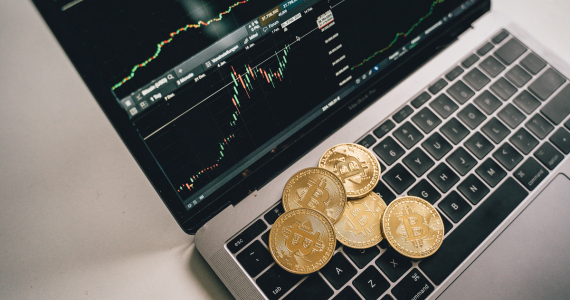Crypto-assets (crypto) mean digital assets including cryptocurrencies, coins or tokens. They digitally represent your ownership of a value or rights to something. They may or may not be backed by physical assets.
Crypto is a high-risk investment. The value of crypto is very volatile, often fluctuating by huge amounts within a short period.
More than with any other investment, you must be prepared to lose what you invest.
How crypto works
What is crypto
Crypto-assets (crypto) describe an asset class that includes cryptocurrency, digital tokens and coins. It does not exist physically as coins or notes, but as digital tokens stored in a digital “wallet”. These digital tokens rely on cryptography and technology such as blockchain for security and other features. Crypto may or may not have an actual asset behind it.
The Reserve Bank of Australia’s website explains how cryptocurrency and blockchain technology (including mining) works.
Crypto is used for payment systems, to execute automated contracts, and run programs. Anyone can create a crypto-asset, so at any time there can be thousands in circulation.
Why crypto is so volatile
The price of crypto can fluctuate at extreme levels often based solely on market speculation. Factors that can influence the price of crypto include:
-
media focus
-
public announcements
-
individuals with large amounts of a crypto-asset who promote or influence it through social media
So if you buy crypto-assets, be prepared to lose everything that you put in.
How crypto is used
Cryptocurrencies were first developed as a digital currency to use as money. Some stores accept crypto as payment for goods and services. Some ATMs let you withdraw it as physical money.
But crypto is not legal tender in Australia and is not widely accepted as payment. Most people don’t use it for everyday transactions. It is not the sort of investment to use to build your savings.
Once you invest there are no regulatory restrictions on how your funds are used. In some cases, your funds may be used for other investments, such as loans. This may jeopardise your investment.
Buying and storing crypto
You can buy or sell crypto on a trading platform using money. Or buy or sell it directly.
Crypto is kept in a unique digital or software wallet (hot) or hardware (cold) wallet. Each wallet has private keys (unique codes) that authorise transactions on the blockchain network.
A hardware wallet stores these private keys on a secure device not connected to the internet. This can protect the wallet from hackers.
A software wallet is held by an individual or by a crypto trading platorm on your behalf. This can simplify buying, selling and storing crypto, but is not a regulated service. So you may not be able to recover the crypto if the trading platform fails.
Scam alert: an increased number of Australians have reported losing money through crypto-asset or cryptocurrency scams.
Types of crypto-assets
Each crypto-asset has different capabilities. Most were not created to be investments.
There are no universally defined categories of crypto-assets. Some common types are listed below, but this does not cover them all. New cryptos are created all the time, but many aren’t well structured and don’t last.
Cryptocurrencies
What are they
Assets designed to act as a medium of exchange, with transfers enabled on blockchains. Cryptocurrencies have no intrinsic value and are only worth what people are willing to pay for them.
Examples include: BTC, ETH, Litecoin
Stablecoins
A ‘Stablecoin’ is a marketing term for crypto that aims to maintain a stable value relative to a specified asset, or basket of assets.
Many aim to track the value of a government issued currency (for example, USD). Some track other assets such as gold, equities, bonds or other crypto.
Stablecoins try to stabilise their market value by:
-
being physically backed 1-for-1 by an external asset, such as government-issued currency, gold or securities
-
being physically backed by a variety of assets where the value of these assets is intended to be greater than the value of the Stablecoin on issue
-
using algorithms to control the available demand and supply of the asset, such as minting additional assets or changing an interest rate for holding the asset
Examples include: Tether, USDC, TrueAUD, DAI
Non-Fungible Tokens (NFTs)
What are they
NFTs are tokens which record ownership of an object using blockchains. Each NFT is unique (hence they are not ‘fungible’). However, owning an NFT may not give you exclusive rights to the underlying asset.
Examples include: Board Apes, game tokens
DeFi tokens
What are they
These are tokens created through participating in decentralised finance (DeFi) protocols. Each token will have unique features based on the DeFi protocol that it relates to.
Other token types
What are they
There are a broad range of terms for other types of tokens. Some types include:
-
utility tokens — allow you to undertake certain activities, or perform an action, in a crypto project, such as being exchanged for a service
-
governance tokens — these allow you to participate in the running of a crypto project
-
community (or membership) tokens — ownership gives you access to the community
Why investing in crypto is high-risk
Crypto is largely not regulated
Many crypto-assets and other digital assets are not commonly considered to be financial products. Because of this, the platform where you buy and sell crypto may not be regulated by ASIC. So you may not be protected if the platform fails or is hacked.
When a crypto-asset fails, you will most likely lose all the money you put in. In most countries, crypto is not legal tender. You’re only protected to the extent that crypto fits within existing laws.
The value depends largely on popular opinion
Investing in crypto-assets is highly speculative. The market value can fluctuate a lot over short periods of time. It is affected by things like media hype and investor opinion.
The price of unbacked crypto may depend on:
-
its popularity at a given time (influenced by factors like the number of people using it)
-
how easy it is to trade or use
-
the perceived value of the currency
-
its underlying blockchain technology
Your money could be stolen
Be aware that a hacker can potentially steal the contents of your digital wallet.
Crypto systems allow users to stay relatively anonymous and there is no central data bank. So if a hacker steals your crypto, you have little hope of getting it back.
Using a wallet held offline, a ‘hardware wallet’ or ‘cold storage’, may offer more protection.
Technically complex
Crypto-assets can be hard to understand.
There is usually no product disclosure statement or prospectus that explains clearly how the crypto works. Developers may issue a ‘whitepaper’ to describe it, but these can vary in format and information.
A crypto-asset’s code may not be available to review. Or it may be written in obscure computing language. The underlying code of the crypto may also change over time.
To access a crypto network, you may need special software and need to know how transaction fees operate. Unfamiliar users run the risk of:
-
sending a transaction to an incorrect address
-
over-paying on transaction fees called ‘gas’ (sometimes by thousands of dollars)
-
not paying enough for a transaction fee (and so losing the fee and transaction)
Crypto scams are increasing
Scammers use crypto because transactions are not easy to recover and have limited oversight. Money can quickly be sent overseas and is very hard to trace.
CASE STUDY
Rhett is scammed $97,000 by a fake endorsement
Rhett saw an article on a news website about ‘The biggest deal in Shark Tank history, that can make YOU rich in just 7 days! (Seriously)’
The news article was really an advertisement. It took Rhett to a website that included endorsements from Shark Tank judges for Bitcoin trading software. The endorsements were fake.
Rhett was interested in trading bitcoin, so he provided his contact details. Soon, an Account Manager named Max began calling Rhett. Max called often, pressuring Rhett to open a trading account and make a deposit. By depositing between $40,000 and $50,000 upfront, Max promised Rhett he could earn at least $15,000 per month.
Max promised Rhett that the money he deposited would be safe because he would have total control of the account. “It’s more or less moving your money in your left pocket from your right pocket,” Max said. Max promised Rhett that he could withdraw his money whenever he wanted to.
Max eventually convinced Rhett to open an account and deposit $40,000. Rhett started trading bitcoin, but things didn’t go to plan, and Rhett started losing money. Max encouraged Rhett to deposit more money and promised Rhett that he would be able to withdraw the money he needed in a week.
Rhett deposited more money in the hope he could recoup his losses. Rhett ended up depositing and losing a total of $97,000.
Source:
Reproduced with the permission of ASIC’s MoneySmart Team. This article was originally published at https://moneysmart.gov.au/investment-warnings/cryptocurrencies
Important note: This provides general information and hasn’t taken your circumstances into account. It’s important to consider your particular circumstances before deciding what’s right for you. Although the information is from sources considered reliable, we do not guarantee that it is accurate or complete. You should not rely upon it and should seek qualified advice before making any investment decision. Except where liability under any statute cannot be excluded, we do not accept any liability (whether under contract, tort or otherwise) for any resulting loss or damage of the reader or any other person. Past performance is not a reliable guide to future returns.
Important
Any information provided by the author detailed above is separate and external to our business and our Licensee. Neither our business nor our Licensee takes any responsibility for any action or any service provided by the author. Any links have been provided with permission for information purposes only and will take you to external websites, which are not connected to our company in any way. Note: Our company does not endorse and is not responsible for the accuracy of the contents/information contained within the linked site(s) accessible from this page.




